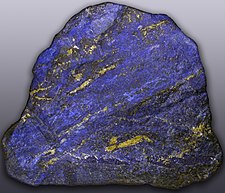Lapis-lazuli
| Lapis lazuli | |
|---|---|

Lapis lazuli from Afghanistan in its natural state
|
|
| General | |
| Category | Metamorphic rock |
|
Formula (repeating unit) |
mixture of minerals with lazurite as the main constituent. |
| Crystal system | None, as lapis is a rock. Lazurite, the main constituent, frequently occurs as dodecahedra |
| Identification | |
| Color | Blue, mottled with white calcite and brassy pyrite |
| Crystal habit | Compact, massive |
| Fracture | Uneven-Conchoidal |
| Mohs scale hardness | 5–5.5 |
| Luster | dull |
| Streak | light blue |
| Specific gravity | 2.7–2.9 |
| Refractive index | 1.5 |
| Other characteristics | The variations in composition cause a wide variation in the above values. |
Lapis lazuli (/ˈlæpɪs ˈlæzjuːli/, /-ˈlæzjuːlaɪ/), or lapis for short, is a deep blue metamorphic rock used as a semi-precious stone that has been prized since antiquity for its intense color. As early as the 7th millennium BC, lapis lazuli was mined in the Sar-i Sang mines, in Shortugai, and in other mines in Badakhshan province in northeast Afghanistan. Lapis was highly valued by the Indus Valley Civilisation (3300–1900 BC). Lapis beads have been found at Neolithic burials in Mehrgarh, the Caucasus, and even as far from Afghanistan as Mauritania. It was used in the funeral mask of Tutankhamun (1341–1323 BC).
At the end of the Middle Ages, lapis lazuli began to be exported to Europe, where it was ground into powder and made into ultramarine, the finest and most expensive of all blue pigments. It was used by some of the most important artists of the Renaissance and Baroque, including Masaccio, Perugino, Titian and Vermeer, and was often reserved for the clothing of the central figures of their paintings, especially the Virgin Mary.
...
Wikipedia
